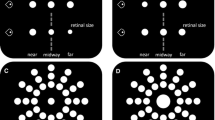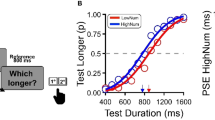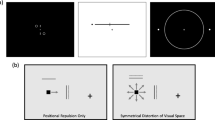Abstract
Target detection is affected by stimulus intensity. For instance, participants respond faster to larger objects than to smaller objects. In order to compute an object’s size, the brain integrates contextual information, for example object distance. Accordingly, the perceived size of an object can be altered via depth cues which modulate perceived object distance. Recently, it has been demonstrated that reaction times are influenced by the perceived rather than by the retinal size of an object, thus indicating that manual responses are generated after the perceptual integration of distance and retinal size. However, the timing aspects of these integration processes to date remain largely unclear. Therefore, the present study investigated the influence of stimulus duration on size–distance integration by means of a simple reaction time paradigm and the well-known Ponzo illusion. In experiment 1, participants responded faster to perceptually longer lines within an illusion-inducing background, whereas no such effect was associated with a neutral background. Experiment 2 revealed that this effect depended on stimulus duration. Stimuli were reliably perceived even with the shortest durations. However, illusion-induced modulations of response times were not observed for stimulus durations shorter than 40 ms. The findings indicate that the integration of context and object information requires visual input to last for at least 40 ms. The data furthermore show that as long as the visual system has not enough time to integrate context and object information, size perception is formed on the basis of lower-level representations.



Similar content being viewed by others
References
Arnold DH, Birt A, Wallis TSA (2008) Perceived size and spatial coding. J Neurosci 28:5954–5958
Bacon-Macé N, Macé MJ-M, Fabre-Thorpe M, Thorpe SJ (2005) The time course of visual processing: backward masking and natural scene categorisation. Vision Res 45:1459–1469
Blanz V, Tarr MJ, Bülthoff HH (1999) What object attributes determine canonical views? Perception 28:575–599
Bulatov A, Bertulis A (2005) Distracting effects in length matching. Acta Neurobiol Exp (Wars) 65:265–269
Cattell JM (1886) The influence of the intensity of the stimulus on the length of the reaction time. Brain 8:512–515
Coren S, Girgus JS (1978) Seeing is deceiving: psychology of visual illusions. Lawrence Erlbaum Associates, Hillsdale, NJ
Fang F, Boyaci H, Kersten D, Murray SO (2008) Attention-dependent representation of a size illusion in human V1. Curr Biol 18:1707–1712
Gajewski DA, Philbeck JW, Pothier S, Chichka D (2010) From the most fleeting of glimpses: on the time course for the extraction of distance information. Psychol Sci 21:1446–1453
Gordon IE (1967) Stimulus probability and simple reaction time. Nature 215:895–896
Gregory RL (1963) Distortion of visual space as inappropriate constancy scaling. Nature 199:678–680
Gregory RL (1997) Knowledge in perception and illusion. Philos Trans R Soc Lond B Biol Sci 352:1121–1127
Konkle T, Oliva A (2011) Canonical visual size for real-world objects. J Exp Psychol Hum Percept Perform 37:23–37
Lamme VAF, Roelfsema PR (2000) The distinct modes of vision offered by feedforward and recurrent processing. Trends Neurosci 23:571–579
Lamme VAF, Zipser K, Spekreijse H (2002) Masking interrupts figure-ground signals in V1. J Cogn Neurosci 14:1044–1053
Leibowitz H, Brislin R, Perlmutter L, Hennessy R (1969) Ponzo perspective illusion as a manifestation of space perception. Science 166:1174–1176
Macmillan NA, Creelman CD (1991) Detection theory: a user’s guide. Cambridge University Press, Cambridge
Müller HJ, Busch A (2006) Visual search for size-defined target objects is modulated by the Ebbinghaus apparent-size illusion: facilitatory and inhibitory effects of the context objects. Perception 35:671–700
Murray SO, Boyaci H, Kersten D (2006) The representation of perceived angular size in human primary visual cortex. Nat Neurosci 9:429–434
Näätänen R (1972) Time uncertainty and occurence uncertainty of the stimulus in a simple reaction time task. Acta Psychol 36:492–503
Osaka N (1976) Reaction time as a function of peripheral retinal locus around fovea: effect of stimulus size. Percept Mot Skills 42:603–606
Pöppel E (1978) Time perception. In: Held R, Leibowitz HW, Teuber H-L (eds) Handbook of sensory physiology, vol VIII. Springer, Berlin, pp 713–729
Pöppel E (1997) A hierarchical model of temporal perception. Trends Cogn Sci 1:56–61
Pöppel E (2009) Pre-semantically defined temporal windows for cognitive processing. Phil Trans R Soc B 364:1887–1896
Posner MI (1980) Orienting of attention. Q J Exp Psychol 32:3–25
Pressey AW, Epp D (1992) Spatial attention in Ponzo-like patterns. Percept Psychophys 52:211–221
Prinzmetal W, Shimamura AP, Mikolinski M (2001) The Ponzo illusion and the perception of orientation. Percept Psychophys 63:99–114
Robertson LC, Kim M-S (1999) Effects of perceived space on spatial attention. Psychol Sci 10:76–79
Robinson AE, de Sa VR (2008) Brief presentations reveal the temporal dynamics of brightness induction and White’s illusion. Vision Res 48:2370–2381
Ross LE, Ross SM (1980) Saccade latency and warning signals: stimulus onset, offset, and change as warning events. Percept Psychophys 27:251–257
Sperandio I, Savazzi S, Gregory RL, Marzi CA (2009) Visual reaction time and size constancy. Perception 38:1601–1609
Sperandio I, Savazzi S, Marzi CA (2010) Is simple reaction time affected by visual illusions? Exp Brain Res 201:345–350
Suzuki K, Imanaka K (2009) Relationships among visual awareness, reaction time, and lateralized readiness potential in a simple reaction time task under the backward masking paradigm. Percept Mot Skills 109:187–207
Tarr MJ (1995) Rotating objects to recognize them: a case study on the role of viewpoint dependency in the recognition of three-dimensional objects. Psychon Bull Rev 2:55–82
Taylor MM, Creelman CD (1967) PEST: efficient estimates on probability functions. J Acoust Soc Am 41:782–787
Ulrich R, Rinkenauer G, Miller J (1998) Effects of stimulus duration and intensity on simple reaction time and response force. J Exp Psychol Hum Percept Perform 24:915–928
Acknowledgments
RW is supported by the Deutsche Forschungsgemeinschaft (DFG, WE 4299/2-1).
Author information
Authors and Affiliations
Corresponding author
Rights and permissions
About this article
Cite this article
Plewan, T., Weidner, R. & Fink, G.R. The influence of stimulus duration on visual illusions and simple reaction time. Exp Brain Res 223, 367–375 (2012). https://doi.org/10.1007/s00221-012-3265-7
Received:
Accepted:
Published:
Issue Date:
DOI: https://doi.org/10.1007/s00221-012-3265-7




